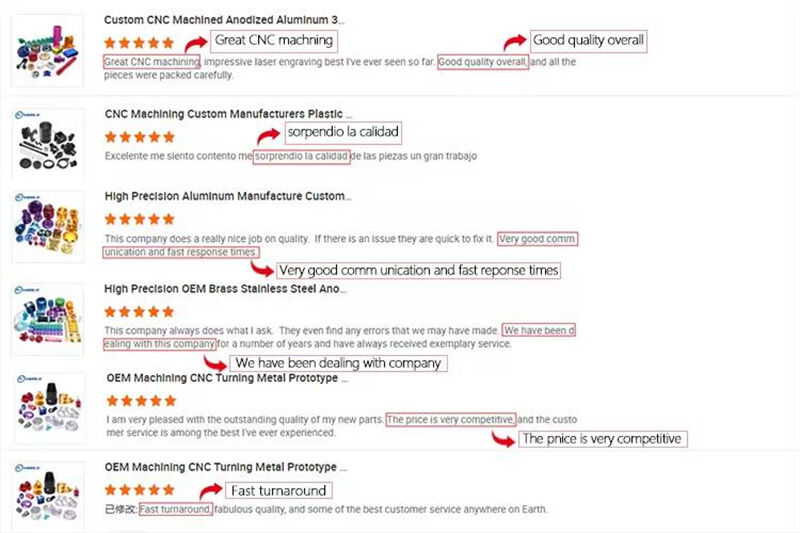Building 49, Fumin Industrial Park, Pinghu Village, Longgang District
Sunday Closed
Precision Machining Parts
Type:Broaching, DRILLING, Etching / Chemical Machining, Laser Machining, Milling, Other Machining Services, Turning, Wire EDM, Rapid Prototyping
Model Number:OEM
Keyword:CNC Machining Services
Material: stainless steel aluminum alloy brass metal plastic
Processing method :CNC Turning
Delivery time:7-15 days
Quality:High End Quality
Certification:ISO9001:2015/ISO13485:2016
MOQ:1Pieces
You've probably heard of CNC machining. Maybe you picture a giant factory floor with machines churning out metal parts. And you're not wrong! But what exactly can these machines do for you? If you're an engineer, a product designer, or an entrepreneur with a great idea, knowing the most common CNC fabrication services is like knowing what tools are in your workshop.
Let's pull back the curtain and look at the everyday jobs that CNC handles. This isn't just about raw metal blocks; it's about the processes that turn those blocks into the precise parts that keep our world running.

In a nutshell, CNC (Computer Numerical Control) uses computer instructions to control powerful machines that cut, shape, and drill material. It's like a super-precise, incredibly strong robotic sculptor that can work for hours with perfect accuracy.
Now, let's get into the good stuff. Here are the most common services you'll find at a CNC fabrication shop.
1. CNC Milling: The All-Star Workhorse
This is probably the most common service you'll encounter. Imagine a cutting tool spinning at incredibly high speeds, moving across a stationary block of material to carve it away.
• What it's best for: Creating complex 3D shapes, slots, pockets, and contours. Think engine components, custom machinery parts, mold tools, and architectural models.
• You'd use this if: You need a part with a lot of geometric detail on multiple faces.
2. CNC Turning: For All Things Round
If milling is like a detail-oriented sculptor, turning is the master potter at his wheel. The material (bar stock) spins rapidly, while a stationary cutting tool shapes it.
• What it's best for: Producing cylindrical or conical parts. We're talking shafts, bolts, bushings, pulleys, and fluid valves.
• You'd use this if: Your part is defined by its radial symmetry. Many shops offer CNC Turning Centers that combine turning and milling in one machine for highly complex rotational parts.
3. CNC Drilling & Tapping: The Foundation of Assembly
While milling and turning machines can drill, dedicated CNC drilling is all about precision hole-making. Tapping is the follow-up act—it cuts the internal threads inside those holes so screws can fasten into them.
• What it's best for: Creating accurate hole patterns in parts like engine blocks, electronic enclosures, and mounting plates.
• You'd use this if: You have a part that needs a large number of perfectly aligned holes for assembly.
4. CNC Routing: For the Big, Bold, and (Not Just) Woody
A CNC router works like a milling machine but is often built for larger, less dense materials. They are the go-to for sheets of material.
• What it's best for: Cutting, carving, and engraving wood, plastics, composites, and non-ferrous metals. Common applications include sign-making, custom furniture, plastic prototypes, and aerospace composite panels.
• You'd use this if: You're working with sheet goods or need to create large-format parts with intricate cutouts.
A huge benefit of CNC is its material versatility. These services aren't limited to steel and aluminum. You can fabricate parts from:
• Metals: Aluminum (the most popular), Stainless Steel, Titanium, Brass, Copper.
• Plastics: ABS, Nylon, Delrin, PEEK, Polycarbonate.
• Others: Wood, Composites, and even Foam.
When you use these services, you're tapping into:
• Unbeatable Precision: We're talking tolerances within the width of a human hair.
• Material Strength: Parts are carved from solid blocks, making them inherently strong.
• Amazing Consistency: The first part is identical to the thousandth part.
• Speed & Scalability: From a single prototype to a full production run.
The journey is simple. You provide a 3D CAD model. The shop reviews it (a process called DFM - Design for Manufacturability) to suggest any tweaks for cost or efficiency. Then, they program the machines, set up the material, and let the CNC work its magic.
Whether you need a one-off functional prototype or a batch of high-strength components, there's a CNC fabrication service ready for the job.



Q: How fast can I receive a CNC prototype?
A: Lead times vary depending on part complexity, material availability, and finishing requirements, but generally:
• Simple prototypes: 1–3 business days
• Complex or multi-part projects: 5–10 business days
Expedited service is often available.
Q: What design files do I need to provide?
A: To get started, you should submit:
• 3D CAD files (preferably in STEP, IGES, or STL format)
• 2D drawings (PDF or DWG) if specific tolerances, threads, or surface finishes are required
Q: Can you handle tight tolerances?
A: Yes. CNC machining is ideal for achieving tight tolerances, typically within:
• ±0.005" (±0.127 mm) standard
• Tighter tolerances available upon request (e.g., ±0.001" or better)
Q: Is CNC prototyping suitable for functional testing?
A: Yes. CNC prototypes are made from real engineering-grade materials, making them ideal for functional testing, fit checks, and mechanical evaluations.
Q: Do you offer low-volume production in addition to prototypes?
A: Yes. Many CNC services provide bridge production or low-volume manufacturing, ideal for quantities from 1 to several hundred units.
Q: Is my design confidential?
A: Yes. Reputable CNC prototype services always sign Non-Disclosure Agreements (NDAs) and treat your files and intellectual property with full confidentiality.
Copyright © Shenzhen Perfect Precision Products Co., Ltd. All Rights Reserved — Privacy Policy — Blog